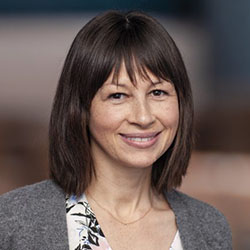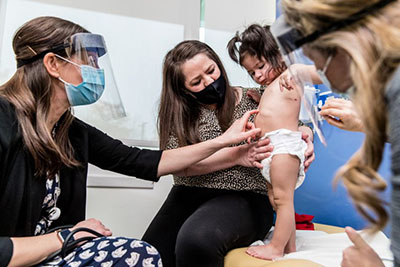The Most Comprehensive Fetal Care and Treatment Center in the Pacific Northwest
2.15.2022 | Ashley Pineda and Seattle Children's Press Team
 Seattle Children’s and University of Washington Medicine launched a new program in October 2021 to provide the next generation of fetal care for families around the Northwest and beyond. The two hospitals offer the only fetal intervention and surgery program in the Pacific Northwest. Care will be provided at Seattle Children’s Fetal Care and Treatment Center and UW Medical Center. Dr. Rebecca Stark, co-directs the Maternal Fetal Intervention and Surgery Program with Dr. Martin Walker, and Dr. Bettina Paek.
Seattle Children’s and University of Washington Medicine launched a new program in October 2021 to provide the next generation of fetal care for families around the Northwest and beyond. The two hospitals offer the only fetal intervention and surgery program in the Pacific Northwest. Care will be provided at Seattle Children’s Fetal Care and Treatment Center and UW Medical Center. Dr. Rebecca Stark, co-directs the Maternal Fetal Intervention and Surgery Program with Dr. Martin Walker, and Dr. Bettina Paek.
Dr. Stark, who is also the director of the Congenital Diaphragmatic Hernia program, spoke with On the Pulse about the new Fetal Care and Treatment Center and exciting additions to the center’s services.
Q: As the director of the Congenital Diaphragmatic Hernia Program, can you tell us what your work on congenital diaphragmatic hernia includes?
A: Our work includes the creation of a multidisciplinary program for the treatment of babies with congenital diaphragmatic hernia. A congenital diaphragmatic hernia occurs if the diaphragm does not form completely before birth. This leaves a hole between a baby’s belly and chest and can be life-threatening. Our program spans from the prenatal diagnostic side of things through the inpatient stay including the Neonatal Intensive Care Unit and floor stay, and also includes long-term patient follow ups. We have a core team that spans all three of those phases of care. Our survival rate for children we treat for CDH is 85% – significantly better than the national average. That is due to the multidisciplinary, collaborative care we provide here, which includes surgeons, neonatologists, cardiologists, pulmonologists, dieticians, feeding therapists, among many others, all of whom have a focus on treating babies and children with CDH.
Q: What distinguishes Seattle Children’s Fetal Care and Treatment Center from other fetal programs in the region?
A: There is not a center in the Pacific Northwest that offers what is considered standard of care for some fetal diagnoses. It’s something that we have always needed to offer our community because we (UW and Seattle Children’s) are the major quaternary centers for adults and children in the Pacific Northwest. People from our region should not have to travel to other centers to get fetal intervention for many reasons, one of which is because it creates disparity in access to health care. There are many people that do not have means to travel to fetal centers and, therefore, they aren’t able get fetal intervention, which is not equitable. We treat several long-term congenital diseases at Seattle Children’s that have fetal treatment options that we know improve outcomes, like spina bifida and congenital diaphragmatic hernia. In order to offer the best care for those diseases we need to be able to include fetal therapy.
In the Pacific Northwest, our closest fetal center is probably Colorado Children’s and then University of California San Francisco. Those are very far distances to travel. Though we have a fledgling intervention program, we have a very robust and established fetal diagnostic center and we have brought on two maternal fetal medicine specialists, Dr. Walker and Dr. Paek who have the highest national experience in twin-to-twin transfusion syndrome. They have performed 575 laser fetoscopic laser ablations for twin-to-twin transfusion, with 96.5% of procedures resulting in one or more twin surviving and over 75% resulting in dual survival.
Additionally, as a children’s hospital partnered with UW Medicine, an adult hospital, there is a high level of expertise on both sides.
Q: We were told you and Drs. Martin Walker, Bettina Paek, and Jason Hauptman will launch Seattle Children’s new Fetal Myelomeningocele Repair Program. Could you tell us more about the program and when it will be available for patients?
 A: We are working collaboratively with UW Medicine on a Fetal Myelomeningocele Repair Program for the prenatal treatment of spina bifida and are hoping to be up and running by the end of this year. A myelomeningocele is a defect of the backbone and spinal cord. Before birth, the baby’s spine, the spinal cord and the spinal canal do not form or close normally. It is the most serious form of spina bifida. I believe that offering fetoscopic myelomeningocele (MMC) repair is going to be groundbreaking for the region because currently only open repair is offered on the West Coast.
A: We are working collaboratively with UW Medicine on a Fetal Myelomeningocele Repair Program for the prenatal treatment of spina bifida and are hoping to be up and running by the end of this year. A myelomeningocele is a defect of the backbone and spinal cord. Before birth, the baby’s spine, the spinal cord and the spinal canal do not form or close normally. It is the most serious form of spina bifida. I believe that offering fetoscopic myelomeningocele (MMC) repair is going to be groundbreaking for the region because currently only open repair is offered on the West Coast.
An open MMC repair impacts a mother’s future pregnancies and increases several other risks factors for her versus fetoscopic repair, which involves the placement of small ports into the uterus through which the repair can be done. This decreases the risk of uterine dehiscence, early labor, and makes future pregnancies safer. This benefits the mother and the results from MMC repair are comparable to the open repair for the fetus.
We think Fetoscopic MMC repair is going to become the standard of care in the near future, and that is what we’re focusing on in terms of fetal MMC program, although we will also plan to perform some open MMC repairs as well.
Q: What’s next for the Fetal Care and Treatment Center? Do you have any additional programs or research in the works for this year? Are there any specific goals you’d like to reach?
A: We are planning to start a FETO program, which stands for fetoscopic endoluminal tracheal occlusion, after our fetal MMC program is established. FETO is offered at a handful of fetal centers for the treatment of severe congenital diaphragmatic hernia. This procedure involves placing a balloon in the trachea of the unborn baby, within the fetus to try to expand the lung on the side of the congenital diaphragmatic hernia and then removing that balloon prior to delivery. That has been shown in fetuses with very severe congenital diaphragmatic hernia to have a very significant impact on postnatal survival. It is something that we want to offer here, so we’ve been doing a lot of work to build the program in hopes that we can launch sometime in the next year.